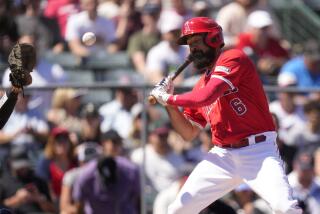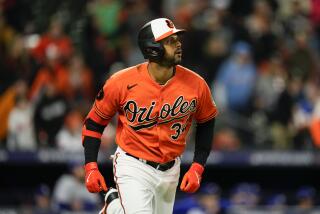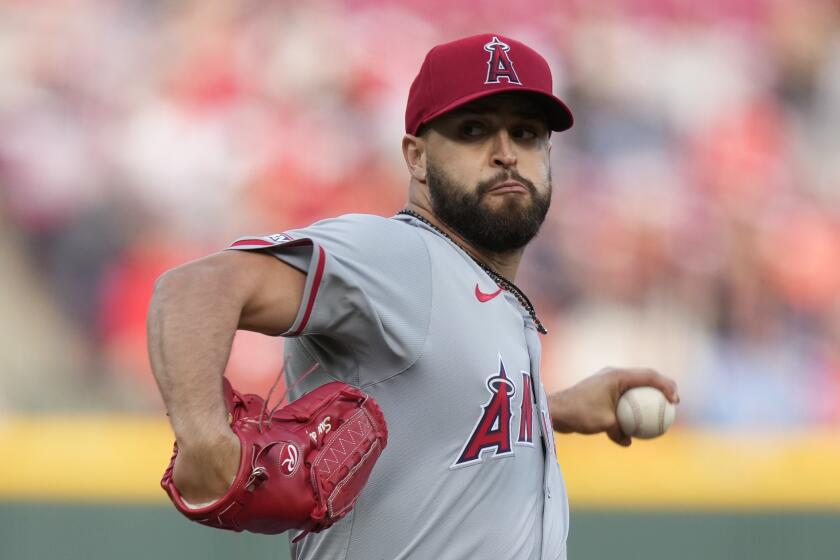Thumb injury was the best thing to happen to Andrelton Simmons
The making of a most-valuable-player candidate, the process that transformed Andrelton Simmons from light-hitting defensive whiz to one of baseball’s best all-around players, did not begin with a prodigious home run or a flurry of drives to the gaps.
It began in the video room, with Simmons’ left thumb in a splint, the Angels shortstop’s torn ligament shutting him down for five weeks in the first half of 2016 and opening his eyes to a different offensive approach.
“Once I had that time, I tried to be useful with it, to really analyze some stuff,” Simmons, 28, said. “I couldn’t do much practice-wise with my hand, so I tried to watch a lot of video, watch a lot of guys hit, and really pay more attention without the stress of having to go into the game.”
Simmons, acquired from Atlanta in November 2015, was batting .219 with a .526 on-base-plus-slugging percentage, one homer and eight RBIs in 31 games when he injured his thumb diving for a ground ball on May 8, 2016.
He returned on June 15 and hit .302 with a .744 OPS, three homers, 18 doubles and 36 RBIs in the final 93 games, and he’s been the Angels’ most consistent and productive hitter not named Mike Trout ever since.
Simmons had a career-best season in 2017, batting .278 with a .752 OPS, 14 homers, 38 doubles and 69 RBIs, finishing eighth in American League MVP voting and winning his third Gold Glove award.
And he’s been even better this season, batting .329 with an .865 OPS, three homers, 10 doubles and 25 RBIs entering Tuesday night’s game at Toronto.
With Major League Baseball on pace to set a record for strikeouts for the 11th consecutive season, Simmons is a rarity, a player with more walks (18) than whiffs (10) through 45 games.
“The coaches were definitely part of it — they helped me get my swing right,” Simmons said of his surgery-induced break and subsequent surge in 2016. “I also tried to simplify things. I started really thinking about my approach more. It helps having a good game plan going into each at-bat.
“I try not to swing at balls. I’m trying to be disciplined, stay focused and have a good at-bat. I’m still not an Albert Pujols or Mike Trout type of guy, but slowly, it’s paying off.”
Simmons was a .256 hitter with a .666 OPS in four seasons for the Braves, usually batting in the lower third of the order and often trying to slap balls the other way.
He showed some power with 17 homers and a .396 slugging percentage in 2013, but that seemed like more of an aberration when Simmons hit seven homers with a .331 slugging percentage in 2014 and four homers with a .338 slugging percentage in 2015.
“We acquired him as a 25-year-old who was heading into those peak years, so we felt the arrow was still pointing up, that he just needed a high volume of at-bats to get better offensively,” Angels general manager Billy Eppler said.
“I can’t really say to the degree, but what he’s doing now is putting him in extremely elite company. The best defender on the planet walking around with a north-of-.400 on-base-percentage at shortstop? Yeah, that’s going to be elite-level value and impact for this club.”
Simmons didn’t overhaul his swing and approach; he tweaked them. He’s still an aggressive hitter who is averaging 3.29 pitches per plate appearance, the third-lowest in the major leagues, but he is more selective within at-bats, better anticipating and identifying the pitches — types and location — he can drive.
According to Fangraphs, he has a career-low 20.7% chase rate this season, far below his 27.9% career average, and a career-low 41.7 swing percentage. But his contact rate (88.7%) is in line with his 88% career average.
“He has an enlightened awareness of his approach and his strengths,” Eppler said, “and he’s maximizing those.”
One of those strengths is turning on inside pitches and hitting them with authority. In 530 games before his thumb injury, according to Brooks Baseball, Simmons hit .260 with a .342 slugging percentage on inside pitches. In 296 games since, he’s batting .378 with an .829 slugging percentage on such pitches.
He also handles pitches that are up and in the middle of the zone or away, batting .409 (18 of 44) on such pitches after his thumb injury and .209 (14 for 67) before surgery.
Simmons drove such a pitch, a high-and-away 95-mph fastball from Anthony Banda in the seventh inning of Sunday’s 5-2 victory over Tampa Bay, into right field for a single that advanced Trout from first to third. Trout scored an insurance run on Zack Cozart’s sacrifice fly.
“I’m making better contact and finding holes — they’re falling more in the gaps than to the outfielders,” said Simmons, a native of Curacao. “It took time to really understand the game better and to understand myself, to know what I do well and try to do that more often. I’m still trying to improve on stuff I don’t do well.”
That to-do list is short. Simmons has hit well enough to bat cleanup seven times and in the fifth spot 119 times for the Angels, and his offensive prowess has not detracted from his defense; according to Fangraphs, he has a major league-best 54 defensive runs saved since the start of 2016.
As much as he appreciates the top-10 MVP finish, which validated his talents and hard work, Simmons is not motivated by such accolades.
“It’s pretty cool to end up where I did in the voting, but the goal is to win a championship,” Simmons said. “I always knew what I was capable of offensively — if you don’t believe in yourself, you don’t stand a chance — but I’m still not satisfied. I’m never really satisfied.
“I want to be better. We all strive to be like Mike Trout. I try to be great each at-bat, each ground ball I get … but I also accept that I’m not perfect.”
More to Read
Go beyond the scoreboard
Get the latest on L.A.'s teams in the daily Sports Report newsletter.
You may occasionally receive promotional content from the Los Angeles Times.







